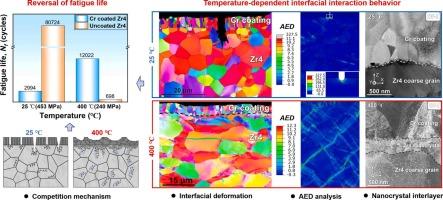Role of interfacial interaction in the temperature-dependent fatigue behavior of Cr-coated Zr-4 alloy
IF 6.8
2区 材料科学
Q1 ENGINEERING, MECHANICAL
引用次数: 0
Abstract
This study systematically investigates the temperature-dependent fatigue mechanisms of Cr-coated Zr-4 alloy, focusing on interfacial interactions under cyclic loadings. At 25 °C, channel cracks occurred in the brittle Cr coating, propagating into the Zr-4 substrate and inducing localized stress concentrations at the interface that accelerated fatigue failure. In contrast, at 400 °C, the Cr coating exhibited remarkable ductility, suppressing substrate plastic deformation and crack initiation at the interface. Crystal plasticity simulations demonstrated that the Cr coating reduced accumulated energy dissipation in the interfacial region at 400 °C, delaying crack nucleation. A critical discovery was the formation of a 300–500 nm-thick nanocrystalline Zr layer at the interface, triggered by dynamic recrystallization during cyclic loading. This layer featured refined grains (∼100 nm), which mitigated dislocation accumulation, redistributed strain, and enhanced interfacial cohesion. Furthermore, the presence of {} deformation twins within the nanocrystals synergized with slip, expanding the pathways for plastic deformation and consequently enhancing the plastic deformability of the nanocrystalline layer. The interplay of Cr coating ductility, grain morphology transition (columnar-to-equiaxed), and interfacial nano-crystallization synergistically improved fatigue resistance at 400 °C. These findings underscore the critical role of temperature-modulated interfacial deformation mechanisms in governing fatigue performance, providing a foundation for optimizing Cr-coated Zr-4 alloys in high-temperature nuclear applications.

界面相互作用在cr包覆Zr-4合金温度依赖性疲劳行为中的作用
本研究系统地研究了cr涂层Zr-4合金的温度依赖疲劳机制,重点研究了循环载荷下的界面相互作用。在25℃时,脆性Cr涂层中出现通道裂纹,扩展到Zr-4基体中,并在界面处引起局部应力集中,加速了疲劳破坏。相比之下,在400℃时,Cr涂层表现出显著的延展性,抑制了基体的塑性变形和界面处的裂纹萌生。晶体塑性模拟表明,在400℃时,Cr涂层降低了界面区域的累积能量耗散,延缓了裂纹的形核。一个关键的发现是,在循环加载过程中,在界面处形成了300-500 nm厚的纳米晶Zr层,这是由动态再结晶引发的。该层具有精细晶粒(~ 100 nm),减轻了位错积累,重新分配了应变,增强了界面内聚。此外,纳米晶中{101¯2}变形孪晶的存在与滑移协同作用,扩大了塑性变形的途径,从而提高了纳米晶层的塑性变形能力。Cr涂层的延展性、晶粒形态转变(柱状到等轴)和界面纳米结晶的相互作用协同提高了400℃下的抗疲劳性能。这些发现强调了温度调制界面变形机制在控制疲劳性能中的关键作用,为优化高温核应用中的cr包覆Zr-4合金提供了基础。
本文章由计算机程序翻译,如有差异,请以英文原文为准。
求助全文
约1分钟内获得全文
求助全文
来源期刊

International Journal of Fatigue
工程技术-材料科学:综合
CiteScore
10.70
自引率
21.70%
发文量
619
审稿时长
58 days
期刊介绍:
Typical subjects discussed in International Journal of Fatigue address:
Novel fatigue testing and characterization methods (new kinds of fatigue tests, critical evaluation of existing methods, in situ measurement of fatigue degradation, non-contact field measurements)
Multiaxial fatigue and complex loading effects of materials and structures, exploring state-of-the-art concepts in degradation under cyclic loading
Fatigue in the very high cycle regime, including failure mode transitions from surface to subsurface, effects of surface treatment, processing, and loading conditions
Modeling (including degradation processes and related driving forces, multiscale/multi-resolution methods, computational hierarchical and concurrent methods for coupled component and material responses, novel methods for notch root analysis, fracture mechanics, damage mechanics, crack growth kinetics, life prediction and durability, and prediction of stochastic fatigue behavior reflecting microstructure and service conditions)
Models for early stages of fatigue crack formation and growth that explicitly consider microstructure and relevant materials science aspects
Understanding the influence or manufacturing and processing route on fatigue degradation, and embedding this understanding in more predictive schemes for mitigation and design against fatigue
Prognosis and damage state awareness (including sensors, monitoring, methodology, interactive control, accelerated methods, data interpretation)
Applications of technologies associated with fatigue and their implications for structural integrity and reliability. This includes issues related to design, operation and maintenance, i.e., life cycle engineering
Smart materials and structures that can sense and mitigate fatigue degradation
Fatigue of devices and structures at small scales, including effects of process route and surfaces/interfaces.
 求助内容:
求助内容: 应助结果提醒方式:
应助结果提醒方式:


